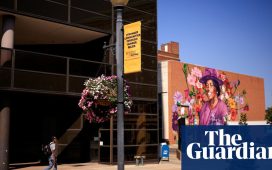Kumar, 24, and his wife were eating dinner at their home in the north Indian state of Gujarat when rocks crashed through two front windows. As they took cover, Kumar said he glimpsed a car driving away – with a bumper sticker for the country’s Hindu nationalist ruling party, the Bharatiya Janata party or BJP.
A couple of months later, the couple were riding their motorcycle home one night after canvassing a nearby village for the Indian National Congress party, the BJP’s main rival, ahead of the country’s general election last year.
Four men, who Kumar recognized as BJP supporters, blocked the road ahead of him. He swerved, lost control and crashed to the ground, where the men beat him so badly that he couldn’t walk for 10 days, he said. Kumar went to a police station, but two BJP members were waiting there to prevent him from filing a report, he said.
Soon after, a relative told him he had heard that the attackers were looking for him again – so Kumar and his wife decided to flee the country.
“I was scared for my life,” said Kumar, who asked not to use his full name to protect family members still in India. “I thought I was going to get killed.”
Soon, he and his wife were on a plane to Mexico where they joined the growing number of Indians crossing the border to seek asylum in the United States.
After migrants from Latin America, more Indians are detained at the US southern border than citizens of any other country. 2018 (the last year for which figures are available) saw the highest number of detentions ever recorded: nearly 9,000 Indians were caught by the border patrol, a dramatic increase from a decade before when only 77 were caught.
As they make their journey halfway around the world, Indians face the same dangers as other migrants do: they risk rape, robbery and death on the border – a six-year-old Sikh girl died while crossing the Arizona desert in mid-June. And the dangers persist when they reach American soil: five Indian asylum seekers have been on hunger strike for more than 90 days to protest at being held in a Louisiana Ice detention centre, and two of them have been force-fed.
One of the men told the Guardian he fled India after being threatened by Hindu nationalists for converting to Christianity. “I am not a criminal. I never did any crime. I’ve never been to jail,” he said.

In October, Mexican immigration authorities deported 311 Indian citizens – most of them from Punjab – in what they called an “unprecedented” repatriation.
Migration is driven by a host of causes, but many US immigration lawyers say the rise in undocumented Indian migration is linked to the ascent of the BJP – and the sectarian violence the party has inspired.
“If you look at when this uptick began, it really stems from when the BJP came into power,” said Deepak Ahluwalia, an immigration lawyer who frequently works with Indian asylum seekers.
Since Narendra Modi became prime minister in 2014, vigilante violence by militant Hindu nationalists in India has surged. As many as 90% of religious hate crimes in the last decade took place after Modi was elected, according to Factchecker.in, an Indian group that tracks religious hate crimes.
Victims – often Muslims, low-caste individuals and other minorities – have endured forced conversions, fatal beatings and even lynch mobs. Extremist groups have attacked fellow Indians suspected of stealing or slaughtering cows, which are sacred in Hinduism. These vigilante Hindu groups killed at least 44 people between May 2015 and December 2018, according to a recent Human Rights Watch report.
Police have neglected to investigate and prosecute wrongdoers in many cases, and Hindu nationalist political leaders have even defended such attacks. The US Commission on International Religious Freedom denounced the Indian government’s “allowance and encouragement of mob violence against religious minorities” in an April report.
In December, the Indian parliament passed a contentious citizenship bill, which many believe is openly discriminatory against Muslims, sparking protests across the country.
The bill’s passage is the latest in a series of anti-Muslim attacks led by the Modi government, following the detention of thousands of Muslims in Kashmir and a citizenship crackdown in the north-eastern India that left millions of people, mostly Muslims, potentially stateless.

Some academics argue, however, that Indian emigration is more driven by economic factors.
“In the big scheme of things, it is not persecution which is driving global migration. It is the economy,” said Tayyab Mahmud, a law professor at Seattle University School of Law who has testified in asylum proceedings for Indian migrants.
John Lawit, a Dallas-based immigration attorney, said most of his Indian clients were Sikh tenant farmers who were driven out of business by corporate farms.
But other immigration lawyers say they have represented Indian asylum seekers who have faced identity-based violence, including Christians, Muslims, LGBTQ people, and members of lower castes.
Harjinder Singh, a Sikh asylum-seeker from Punjab, argued that the journey from India to the United States is too costly for migrants to leave for economic reasons. He said he left Punjab because he was beaten up by members of the state’s ruling Congress party for belonging to the Sikh Shiromani Akali Dal party.
“It’s people that can afford to come here,” he said. “People that can pay 40,000 dollars.”
Indian asylum seekers often fear that if they stay in India – even if they moved far away from their hometown – they’d still be subject to vigilante violence. And interviews with migrants suggest that many choose to come to the United States because they have family or friends that live there.
Some Indian migrants fly from India to Europe, before arriving in Mexico. Others fly into Central or South America and follow the well-trodden migrant trail into Mexico.
Most Indian migrants, like Kumar, then cross the border near Calexico, a small town in the southern California desert.
Smugglers often drop them off near a three-foot high border wall and tell them to hop over the barrier and keep walking, said agent Eduardo Jacobo, spokesman for the El Centro sector border patrol, where Calexico is located.
None of the local border patrol agents speak Punjabi or Hindi, said Jacobo, adding that he would use hand signals to communicate with the migrants until he could call an interpreter.
“The smugglers all take them to the same spots,” said Jacobo, . “They all look lost and scared.”








